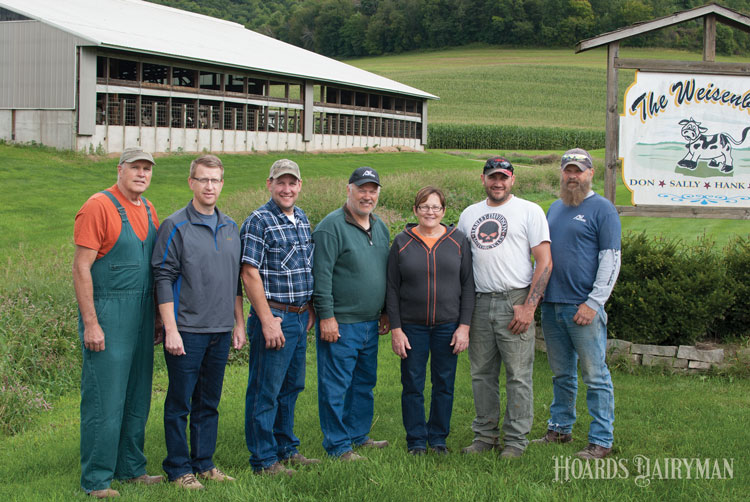
“For us, the Pocket Cow Card on the phone and tablet is a great reference tool when out among the herd,” said Jake Weisenbeck when discussing how his farm tracks heats, breeding records, and other herd health events. “Initially, all records are entered into the Dairy Comp 305 computer software program by our A.I. technician Tim Nemitz and my mother, Sally. In our opinion, Dairy Comp 305 is a great tool,” he said. “All A.I. lists are programmed to print automatically on scheduled days,” further explained the Durand, Wis., dairyman whose farm earned Platinum honors in this year’s Dairy Cattle Reproduction Council’s 10th annual awards competition. For the Weisenbeck family, which includes parents Don and Sally and brothers Jake and Hank, records provide the foundation for their record-setting 47 percent pregnancy rate.
All six of this year’s Platinum winners of the Dairy Cattle Reproduction Council’s awards share additional insight in this Hoard’s Dairyman Intel as well as the Round Table found on pages 695 to 697 of the November issue of Hoard’s Dairyman. This year’s competition drew the second-largest set of nominations to date from 16 U.S. states, Canada, and Italy.
Here are additional responses to the question, “How do you keep track of heats, breeding records, and other herd health events?”
Emerald Spring Dairy, Plainview, Minn.: We use Dairy Comp 305 for all of our record keeping. Protocol lists are generated automatically. Matings are loaded into the cow file. The breeding tech enters all breedings. All of this information is accessible on a tablet via Pocket Cow Card while heat detecting in pens.
Jer-Z-Boyz Ranch, Pixley, Calif.: Dairy Comp 305 has been used on our dairy for well over 25 years. A laptop with DC305, mounted on each “breeding cart,” is in front of every animal to be heat detected and served. A clipboard is kept on the cart to record observed heats, breedings, other health treatment notations, then transcribed into the Dairy Comp 305 computer program late every afternoon. It’s very useful to have all pertinent health information “cowside.”
Plymouth Dairy, LeMars, Iowa: Everything with both our cows and heifers is recorded on Dairy Comp 305. We use handheld computers with wands and RFID (radio frequency identification) tags with both heifers and cows. Breedings are entered into the computer by the breeders, and on herd health days all the information from the veterinarians is put into the hand-held computer and then docked transferred into Dairy Comp 305.
All data is watched carefully by our herd manager and head herdsman. The information from our heifer facility is transferred daily from that DC305 computer to our DC305 computer at the main dairy to aid with monitoring.
Rollin Green Dairy, Brooklyn, Wis.: We utilize Dairy Comp Scout for our record keeping. This allows us to keep track of technician, sire code, breeding code, and so forth. We also keep a paper log that is used by both the A.I. technicians and Jeff. This gives us a second record to refer back to if there are ever any questions on a breeding.
As far as observing heats, the 21-day interval list is printed every Monday for the middle of the week, those cows are tail painted, and that list is kept in Jeff’s pocket all week as a reference. It is in his hand while walking cows three times a day and a constant reminder to be watching those cows.
When painting cows, we rotate color of tail paint every week. This also helps point out what cows to be watching. By keeping good records, it provides good data as to what to do for the next breeding. It also gives us data as to the success of every method.
We always look up the cow before breeding on a standing heat as to what the cow’s status is, look at whether it is at the right interval, and if it has been bred to multiple standing heats. If a cow is bred twice without being checked by the vet, it is usually flagged for vet check after breeding just to make sure it is cycling okay. GnRH is given at every standing heat breeding.
Schilling Dairy, Darlington, Wis.: All reproductive data is recorded in the Dairy Comp 305 herd management software. Heats and breedings are entered by the breeders. Brian records herd health data and ovsynch shots. Dairy Comp is used to provide shot and herd checklists.
This Hoard’s Dairyman Intelarticle is part of a nine-part series detailing top reproduction tips from the Platinum winning herds for the tenth annual Dairy Cattle Reproduction Council awards competition.
Click on the links below to view previous reports from this DCRC series:
They track fresh cow temps for 12 days
How they handle problem-breeding cows
We breed cows one week later, now
We confirm cows pregnant twice








